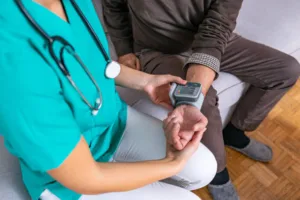Wearable ultrasound imaging:

For decades, traditional ultrasound imaging has been the cornerstone of diagnosing and monitoring heart health. However, the bulky machines and the need for a trained technician limit their accessibility and convenience. But what if you could continuously monitor your heart function with a comfortable patch worn like a smartwatch? This is the exciting potential of wearable ultrasound imaging technology, a revolutionary technology poised to transform how we care for our hearts.
Imagine being able to monitor your heart health in real-time, comfortably from your wrist. No more bulky machines or hospital visits—just a sleek device that provides continuous insights into your heart’s function. This isn’t science fiction; it’s the potential future of healthcare thanks to wearable ultrasound imaging technology.
What is wearable ultrasound imaging technology?
Traditionally, ultrasound imaging involves a large probe pressed against the body to generate sound waves that create images of internal organs. Wearable ultrasound imaging technology takes images of internal organs and miniaturises them into a comfortable patch or band that can be worn on the chest or wrist. These devices use similar principles as traditional ultrasounds but are designed for continuous monitoring and portability.
How does wearable ultrasound imaging technology work?
These innovative devices contain tiny piezoelectric transducers that convert electrical signals into sound waves. These waves travel through the body and bounce back, creating an image of the underlying tissues. Unlike traditional ultrasounds, wearable imaging technology uses flexible materials and advanced algorithms to maintain consistent contact with the skin, even during movement.
Read More: Exploring the Smart Life-Compatible Switches and Plugs
Benefits of Wearable Ultrasound Imaging Technology

The potential benefits of wearable ultrasound imaging technology are vast, with the most significant impact being on heart health monitoring. Here’s how this technology can revolutionise the way we care for our hearts:
1. Continuous Monitoring: Unlike traditional ultrasounds that provide a snapshot in time, wearable imaging technology offers real-time, continuous monitoring of heart function. This allows for earlier detection of abnormalities and potential heart problems.
2. Improved Diagnosis: Early detection of heart issues, such as arrhythmias or heart failure, can lead to more effective treatment and better patient outcomes. Wearable imaging technology could play a crucial role in catching these problems early.
3. Personalised Healthcare: Continuous monitoring allows doctors to personalise treatment plans based on a patient’s specific heart health data. This data can reveal trends and patterns that might not be evident during a single hospital visit.
4. Empowering Patients: Wearable imaging technology empowers patients to take an active role in managing their heart health. Patients who have access to real-time data can make informed decisions about their lifestyle and activities.
5. Remote Monitoring: Wearable imaging technology could allow patients with chronic heart conditions to be monitored remotely. This would reduce the need for frequent hospital visits and improve patient convenience.
6. Early Intervention: Athletes and people with high-risk factors for heart disease can benefit significantly from continuous monitoring. Wearable imaging technology can detect potential problems before they become serious health risks.
The Current Stage of Wearable Ultrasound Imaging Technology Development
Wearable ultrasound imaging technology is still in its early stages of development. Researchers are actively working on refining the technology, improving image quality, and ensuring user comfort. Several prototypes have shown promising results, and ongoing clinical trials are evaluating their effectiveness in real-world settings. While a definitive timeline for widespread availability is yet to be established, the rapid advancements suggest this technology could become a reality within the next few years.
The Future of Wearable Ultrasound Imaging Technology

The future of wearable ultrasound imaging technology is incredibly exciting. As the technology matures, we can expect to see:
1. Improved Image Quality: Advancements in transducer technology and algorithms will lead to sharper and more detailed images, enabling better diagnosis.
2. Multi-Organ Monitoring: Future iterations may be able to monitor not just the heart but also other vital organs, such as the lungs or blood vessels.
3. Integration with Smart Devices: Wearable imaging technology could seamlessly integrate with smartphones and health platforms, allowing for data analysis, trend tracking, and remote consultations with doctors.
Read More: Unveiling Smart Life-Compatible Cameras and Sensors
Beyond Heart Health: The Impact of Wearable Ultrasound Imaging Technology in Other Areas of Medicine
While the initial focus is on heart health, wearable ultrasound imaging technology has the potential to impact other areas of medicine. These devices could be used to monitor muscle function during physical therapy, track lung health in patients with respiratory conditions, or even monitor foetal development during pregnancy.
Potential Impact of Wearable Ultrasound Imaging Technology on the Future of Healthcare
The potential impact of wearable ultrasound imaging technology on the future of healthcare is significant. Here’s how this technology could revolutionise heart health:
1. Personalised Medicine: Wearable imaging technology can provide a wealth of data about your unique heart function. This data can be used to develop personalised treatment plans and preventative strategies tailored to your individual needs.
2. Preventative Care: By enabling early detection, wearable imaging technology can potentially shift the focus from reacting to heart problems to preventing them altogether. This could lead to a significant reduction in heart disease, the leading cause of death globally, according to the World Health Organisation (WHO).
3. Telehealth Applications: Wearable ultrasound imaging technology could play a crucial role in expanding telehealth services. Imagine remotely consulting a doctor who can access your real-time heart data, improving access to care for people in remote areas or those with limited mobility.
Read More: What is Cloud Cam Control for Smart Home Devices?
Addressing Concerns and Considerations With Wearable Ultrasound Imaging Technology

While the potential benefits of wearable ultrasound imaging technology are exciting, some concerns need to be addressed:
1. Data Security: With constant data collection, ensuring the security and privacy of sensitive health information is paramount. Robust cybersecurity measures and clear data privacy policies will be crucial.
2. Cost and Accessibility: As with any new technology, initial costs for wearable imaging technology might be high. Ensuring broad accessibility and affordability will be vital to maximising the positive impact on public health.
3. Data Interpretation: Due to the large amount of data that wearable imaging technology collects, it may take advanced algorithms and trained staff to correctly analyse it.
Conclusion: A Brighter Future for Heart Health
Wearable ultrasound imaging technology represents a revolutionary leap forward in heart health monitoring. With continuous monitoring, early detection capabilities, and the potential for remote applications, this technology has the power to empower individuals, improve preventative care strategies, and ultimately save lives. While challenges remain regarding data security, cost, and interpretation, the rapid advancements in this field suggest a brighter future for heart health for everyone.










